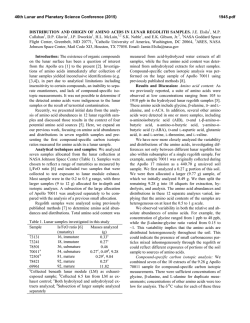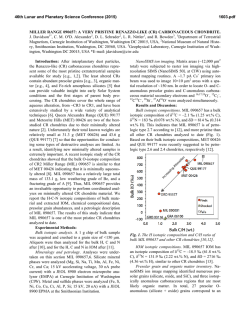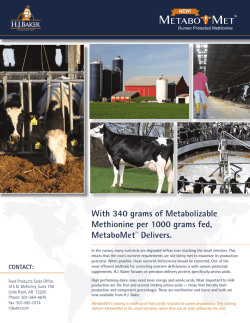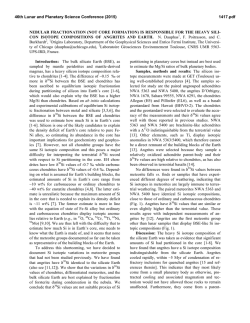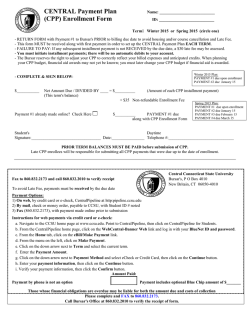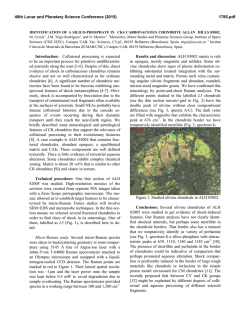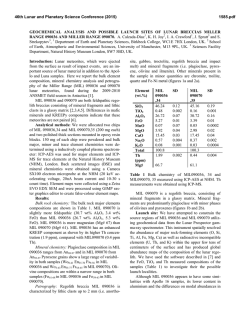
atypical amino acid structural and isotopic - USRA
46th Lunar and Planetary Science Conference (2015) 2242.pdf ATYPICAL AMINO ACID STRUCTURAL AND ISOTOPIC COMPOSITIONS IN THE CR2 CHONDRITE MILLER RANGE 090001 AND THE CH3 CHONDRITE SAYH AL UHAYMIR 290. A. S. Burton1, J. E. Elsila2, E. T. Parker3, D. P. Glavin2, J. P. Dworkin2, and R. Bartoschewitz4. 1NASA Johnson Space Center, Houston, TX 77058; [email protected], 2NASA Goddard Space Flight Center, Greenbelt, MD 20771, 3Department of Chemistry and Biochemistry, Georgia Institute of Technology, Atlanta, GA 30332, 4 Bartoschewitz Meteorite Laboratory, D-38518 Gifhorn, Germany. Introduction: Carbonaceous chondrites contain broad suites of amino acids that vary in abundance and structural complexity depending on the meteorite parent body mineralogy and alteration history [1 – 4]. CR chondrites of petrologic types 2 and 3 and CH3 chondrites have been shown to be particularly rich in amino acids, although the structural distributions of amino acids differ appreciably between the CR and CH chondrites. Insights into the synthetic environment and formation chemistry of meteoritic amino acids have been gained through careful analysis of the structural, enantiomeric and isotopic compositions of meteoritic amino acids [2, 5-7]. Compound-specific isotopic analyses are particularly informative, but require larger sample sizes than structural and enantiomeric measurements. Consequently, isotopic measurements are typically limited to meteorites recovered in large masses or that contain very high abundances of amino acids. Here we report on the structural, enantiomeric and isotopic compositions of amino acids in two large meteorites, the CR2 Miller Range (MIL) 090001 (>6 kg recovered mass) and the CH3 Sayh al Uhaymir (SaU) 290 (~1.8 kg recovered mass). Analytical Techniques and Samples: Amino acids were extracted in hot water (24 h, 100 °C). The supernatant was removed and subjected to acid-vapor hydrolysis to convert acid-labile amino acid precursors and derivatives to free amino acids [free amino acids were also analyzed but will not be discussed here]. Following hydrolysis, the amino acids were purified by cation exchange chromatography, and eluted with a 2M aqueous ammonia solution. The abundance, distribution and enantiomeric compositions of the two- to fivecarbon aliphatic amino acids found in these meteorites were measured by ultrahigh performance liquid chromatography with fluorescence detection and time-offlight mass spectrometry (UPLC-FD/ToF-MS) coupled with o-phthaldialdehyde / N-acetyl-L-cysteine (OPA/NAC) derivatization [8], using the amino acid extracts of a 316 mg sample of MIL 090001 and a 513 mg sample of SaU 290. Compound-specific isotopic ratios were measured by derivatizing the desalted extracts with trifluoroacetic anhydride (TFAA) and isopropanol prior to analysis via gas chromatography and combustion coupled with mass spectrometry and isotope ratio mass spectrometry (GC-MS/IRMS) [5], us- ing a 17.9 g sample of MIL 090001 (for carbon isotopes) and a 9.3 g sample of SaU 290 (for nitrogen isotopes). Results and Discussion: The amino acid abundances measured for both MIL 090001 and SaU 290 were significantly lower than previously observed for other CR2 (Elephant Moraine 92042) and CH3 (Pecora Escarpment 91467) chondrites, by nearly 300-fold, and 40-fold, respectively (Table 1). Table 1. Comparion of selected amino acid abundances (in nmol/g) in some CR2 and CH3 chondrites. MIL EET PCA 090001 92042 SaU 290 91467 Amino (CR2) (CR2) (CH3) (CH3) acid1 [this study] [1] [this study] [4] Glycine 2.56±0.58 727±205 0.98±0.23 61±10 D-alanine 0.62±0.12 450±104 0.25±0.01 2.7±0.3 L-alanine 0.61±0.13 464±84 0.34±0.01 2.5±0.4 β-alanine 2.78±0.44 47±13 0.92±0.03 43±4 α-AIB 0.81±0.08 552±151 0.07±0.01 1.3±0.2 D,L-α-ABA 0.17±0.02 201±54 0.09±0.01 2.9±0.6 D-β-ABA 0.55±0.06 28±6 0.06±0.01 3.3±0.7 L-β-ABA 0.53±0.05 31±8 0.06±0.01 3.7±0.6 γ-ABA 0.22±0.04 25±10 1.13±0.03 5.3±0.6 Total: ~9 ~2500 ~4 ~130 1Abbreviations are: α-AIB = α-aminoisobutyric acid; α-ABA = αaminobutyric acid; β-ABA = β-aminobutyric acid; γ-ABA = γaminobutyric acid. Despite the lower abundances of amino acids in these meteorites, we were able to determine compoundspecific stable isotope ratios for multiple amino acids in each meteorite (Tables 2 and 3). The 13C/12C and 15 N/14N isotopic ratios were significantly enriched in the heavier isotopes comparted to the terrestrial range of isotopic values, unambiguously indicating an extraterrestrial origin [5, 9, 10]. Table 2. δ13C (‰ Vienna Pee Dee Belemnite) values for selected amino acids in CR2 chondrites. Amino acid Glycine D-alanine L-alanine β-alanine α-aminoisobutryic acid D-α-aminobutyric acid γ-aminobutyric acid MIL 090001 (CR2) [this study] 10 ± 3 11 ± 2 11 ± 3 -6 ± 2 -3 ± 6 5±2 -21 ± 4 EET 92042 (CR2) [1] 26 ± 3 29 ± 2 34 ± 4 18 ± 9 25 ± 1 20 ± 2 5±3 46th Lunar and Planetary Science Conference (2015) Table 3. δ15N (‰ Air) values for selected amino acids in CR and CH chondrites. Amino acid Glycine β-alanine γ-aminobutyric acid SAU 290 (CH3) [this study] 167 ± 15 347 ± 5 83 ± 3 EET 92042 (CR2) [1] 140 ± 6 154 ± 23 118 ± 6 Amino acids in MIL 090001 Amino acids in this meteorite were one to two orders of magnitude less abundant than in other CR2 chondrites including EET 92042 (Table 1). In addition, the amino acids in MIL 090001 were all depleted in 13C relative to their counterparts in EET 92042. Previous analyses have shown that MIL 090001 is dissimilar to other CR2 chondrites, including in bulk C abundance and isotopic composition, where MIL 090001 contained less bulk C on a per weight basis (0.69 wt. % for MIL 090001 vs 1.18 wt. % for EET 92042), and that that carbon was enriched in 13C relative to other CR chondrites (10.2 ‰ for MIL 090001 vs 4.9 ‰ for EET 92042) [11, 12]. The lower bulk carbon abundances could be invoked to explain the reduced abundances of amino acids in MIL 090001. The observation that the amino acids in MIL 090001 are depleted in 13C relative to other CR2s despite the general enrichment of 13C in MIL 090001 implies that they come from a different carbon reservoir than the bulk material. In general, the observed decrease in amino acids in MIL 090001 would be consistent with more extensive parent body processing, which tends to reduce the total abundances of amino acids and increase the abundance of β-alanine relative to glycine [1]. Amino acids in SaU 290 The CH3 chondrite SaU 290 was found to contain indigenous amino acids, though in more than 30-fold lower abundances than was observed in other CH3 chondrites (Table 1, [4]). SaU 290 was previously found to contain 117 ppm N, with a δ15N value of 914 ‰ [13]; this abundance is lower than was observed in PCA 91467 (401 ppm N), but more enriched in 15N (792 ‰) [14]. We sought to determine whether or not amino acids were similary enriched in 15N. Because δ15N measurements have not previously been made for amino acids in CH chondrites, we did not have values for a direct comparison. Instead we used amino acid δ15N values from a representative CR2 chondrite, EET 92042, for comparison (Table 3). While values for glycine and γ-aminobutryic acid were very similar between the two meteorites, βalanine was significantly enriched in 15N in SaU 290. This is the highest yet reported δ15N value for an amino acid in a meteorite, though it is still significantly less than the bulk δ15N values observed for CH chondrites. It is unclear why SaU 290 is so depleted in amino acids relative to other CH3 chondrites, though as a find in 2242.pdf Oman it endured a much different weathering regime than other CH3 chondrites that were recovered from Antarctica. Conclusions: Here we report the first amino acid analyses of two of the largest CR (MIL 090001) and CH (SaU 290) chondrites recovered to date. They were both found to contain indigenous amino acids, though in much lower abundances and with different isotopic compositions than other comparable meteorites. Further studies that elucidate the causes of these differences are needed, but will provide valuable insights into the formation and survivability of compounds important to the origins of life in our solar system. References: [1] Glavin D. P. et al. (2010) Meteoritics & Planet. Sci. [2] Burton A. S. et al. (2012) Chem. Soc. Rev. 41, 5459 – 5472. [3] Burton A. S. et al. (2012) Meteoritics & Planet. Sci. 47, 374 – 386. [4] Burton et al. (2013) Meteoritics & Planet. Sci. 48, 390 – 402. [5] Elsila et al. (2012) Meteoritics & Planet. Sci. 47, 1517 – 1536. [6] Pizzarello et al. (1994) Geochim. Cosmochim. Acta. 58, 5579 – 5587. [7] Ehrenfreund P et al. (2001) Proc. Natl. Acad. Sci. USA. 98, 2138 – 2141. [8] Glavin et al. (2006) Meteoritics & Planet Sci. 41, 889 – 902. [9] Scott et al. (2006) Astrobiology 6, 867 – 880. [10] Burton et al. (2014) Meteoritics & Planet. Sci. 49, 2074 – 2086. [11] Alexander et al. (2012) Science 337, 721 – 723. [12] Alexander et al. (2013) Geochim. Et Cosmochim. Acta 123, 244 – 260. [13] Murty et al. (2007) Meteoritics & Planetary Science 42, A113. [14] Sugiura and Zashu (2001) in Meteoritics and Planet. Sci. 36, 515 – 524. Acknowledgements: We thank the C. Satterwhite, K. Righter, the Meteorite Working Group and ANSMET for the samples of MIL 090001 analyzed in this study. J.E.E., D.P.G. and J.P.D. acknowledge funding support from the National Aeronautics and Space Administration (NASA) Astrobiology Institute, the Goddard Center for Astrobiology, the NASA Cosmochemistry Program, and a grant from the Simons Foundation (SCOL award 302497 to J.P.D.). A.S.B. also acknowledges support from the NASA Postdoctoral Program at the Goddard Space Flight Center, administered by Oak Ridge Associated Universities through a contract with NASA. E.T.P. acknowledges funding from the Marine Biology Laboratory’s NASA Planetary Biology Internship Program.
© Copyright 2024
